“You can’t condense all of U.S. History II in six weeks,” Kells says.
Instead, Kells asks his students to interview their family members of different generations and then write about their relatives’ experiences in the context of the historical events of their generations.
Since working at CHSA, Dillingham has tried to incorporate more project-based learning into her classroom during the school year as well.
CHSA was the brainchild in 2001 of Katherine K. Merseth, who directs the Teacher Education Program at the Ed School, and Paula Evans, the former principal of Cambridge Rindge and Latin.
Teacher Education Program participants have their first student teaching experiences at CHSA, where they work under experienced mentor teachers. The Ed School students gain teaching experience and high school students benefit from the lower student-teacher ratio. Merseth calls it a “win-win.”
The experienced and novice teachers motivate each other. “Working with inspiring educators, there is a certain energy and excitement that renews some of your faith and challenges you to take some risks in the classroom,” Kells says of his shared classroom time with new educators.
Every teaching team leads one course for two hours, then spends another two hours assessing their work.
At the end of CHSA, students present their projects at an exhibition night. Local residents are invited, introducing community members outside of the school system to the summertime collaboration between Cambridge schools and Harvard.
Administrators of CSA and CHSA say they hope their innovative summer schools to be used as models for other cities, and Cantabrigians who spent their summers as Harvard students hope for others to be able to share the enriching experiences.
“I just wish there could be more Crimson Summer Academies. It changed my life,” Sealy says.
—Staff writer Kerry M. Flynn can be reached at kflynn@college.harvard.edu.









